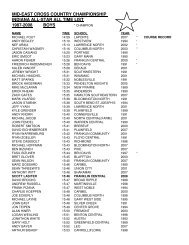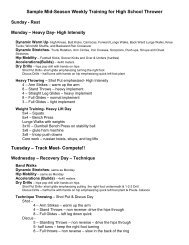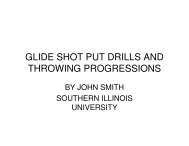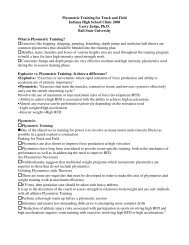Long Jump Approach & Take-off - iatccc
Long Jump Approach & Take-off - iatccc
Long Jump Approach & Take-off - iatccc
You also want an ePaper? Increase the reach of your titles
YUMPU automatically turns print PDFs into web optimized ePapers that Google loves.
TAKE-OFF<br />
When thinking of the take-<strong>off</strong>, think about what happens two steps out from take <strong>off</strong>. Most<br />
problems at the take-<strong>off</strong> can be a result from what happens the last 2 steps (4 strides) in<br />
the approach. In the attack phase of the approach this is where the most steering occurs. If<br />
the athlete is to far out from the mid check step he/she will lengthen their stride to reach<br />
the board. An athlete that is over the check step will then start to cut/chop their steps in<br />
order to not foul.<br />
When evaluating the preparation and take-<strong>off</strong> think of the following!<br />
- Athlete must have good posture. Head & pelvis should be aligned properly. You<br />
should not see the athlete leaning forward or backward<br />
- Correct running mechanics should be present.<br />
- Preparation for the take <strong>off</strong> will require the athlete’s center of mass to lower.<br />
This will help with the transition from horizontal velocity to vertical velocity.<br />
Preparation for take-<strong>off</strong><br />
- The penultimate step prepares the athlete for take-<strong>off</strong><br />
- The lowering of the COM should occur during the support phase of the<br />
penultimate step<br />
- Athlete should keep good posture during preparation<br />
- Think of this action as a pushing towards the board not a “dipping” action<br />
<strong>Take</strong>-<strong>off</strong><br />
- This should blend into the run/approach. Should not see any or much difference<br />
- <strong>Take</strong> <strong>off</strong> foot will be placed just in front of athletes COM.<br />
- Athlete should not lean forward or backwards at take-<strong>off</strong>. This will help<br />
maintain horizontal velocity.<br />
- The COM should continue in a horizontal path until it is over the take-<strong>off</strong> foot.<br />
Then the lifting effect should occur.<br />
- Make sure that athlete blocks other the drive knee and arm, this will help with<br />
converting the horizontal velocity created in the approach into vertical velocity<br />
at take-<strong>off</strong>.<br />
Notes:…….<br />
- Athlete should never slow down at the take <strong>off</strong><br />
- Accelerate throughout the take-<strong>off</strong><br />
- Athlete should be at MAX Controllable speed at take-<strong>off</strong>!!!<br />
- Cue I use for the prep & take-<strong>off</strong> is “Push-Pull”<br />
- For elite jumpers take-<strong>off</strong> angle will be 19-21 degrees<br />
- Prep & take-<strong>off</strong> should be practice early and often<br />
2013 IATCCC Clinic – Indianapolis, IN

















